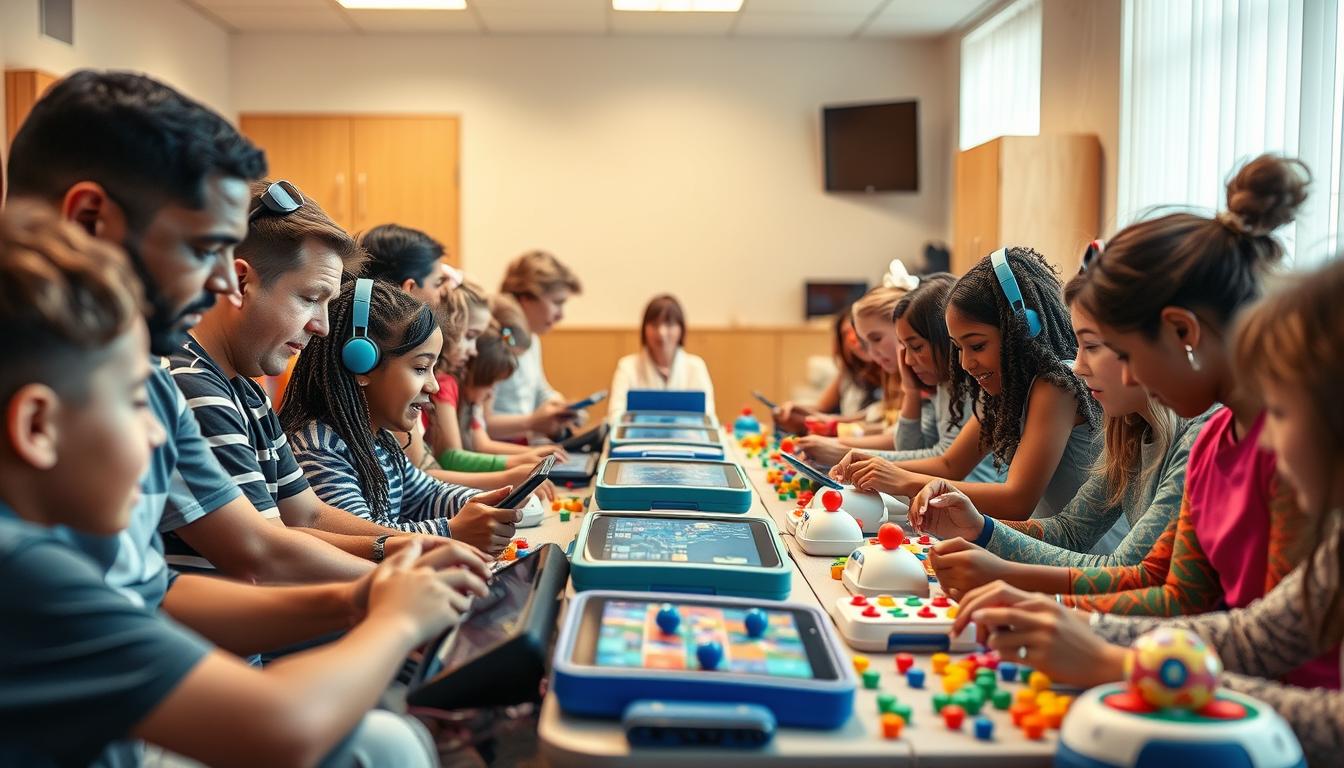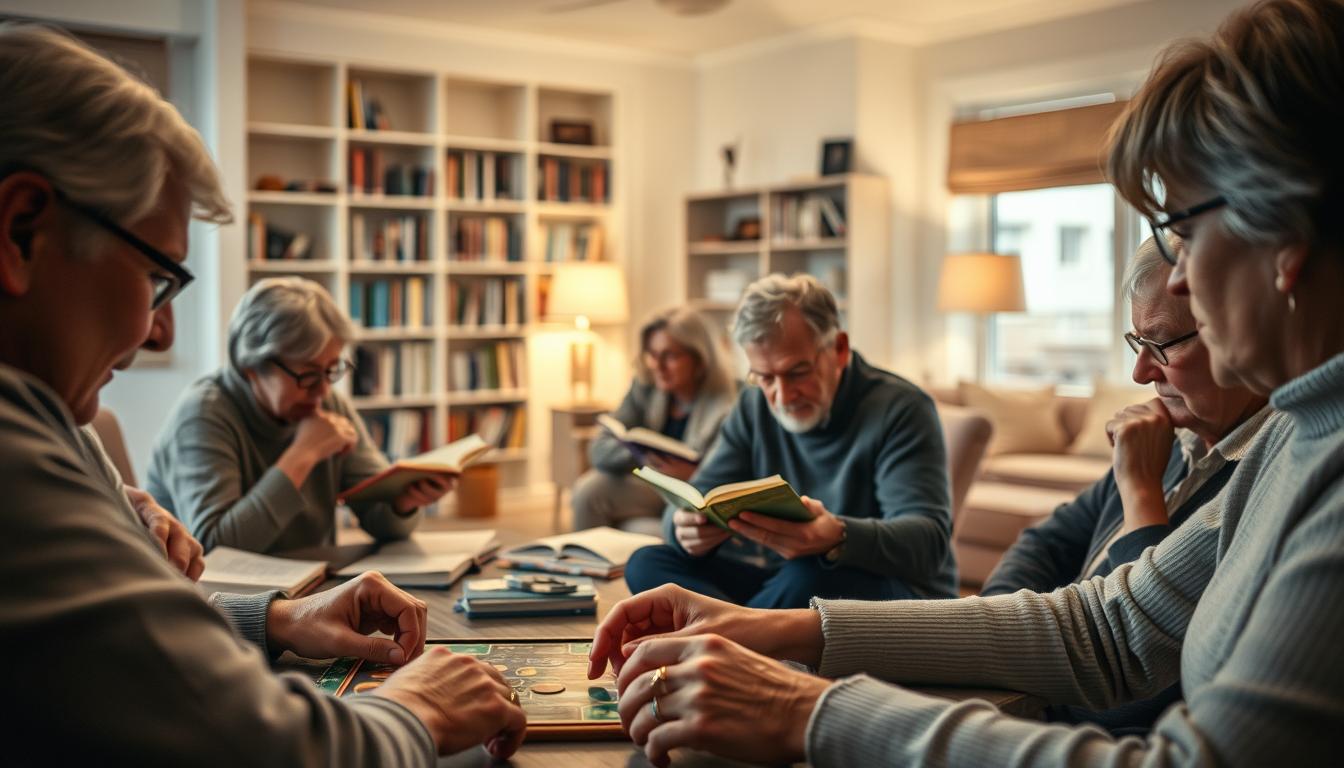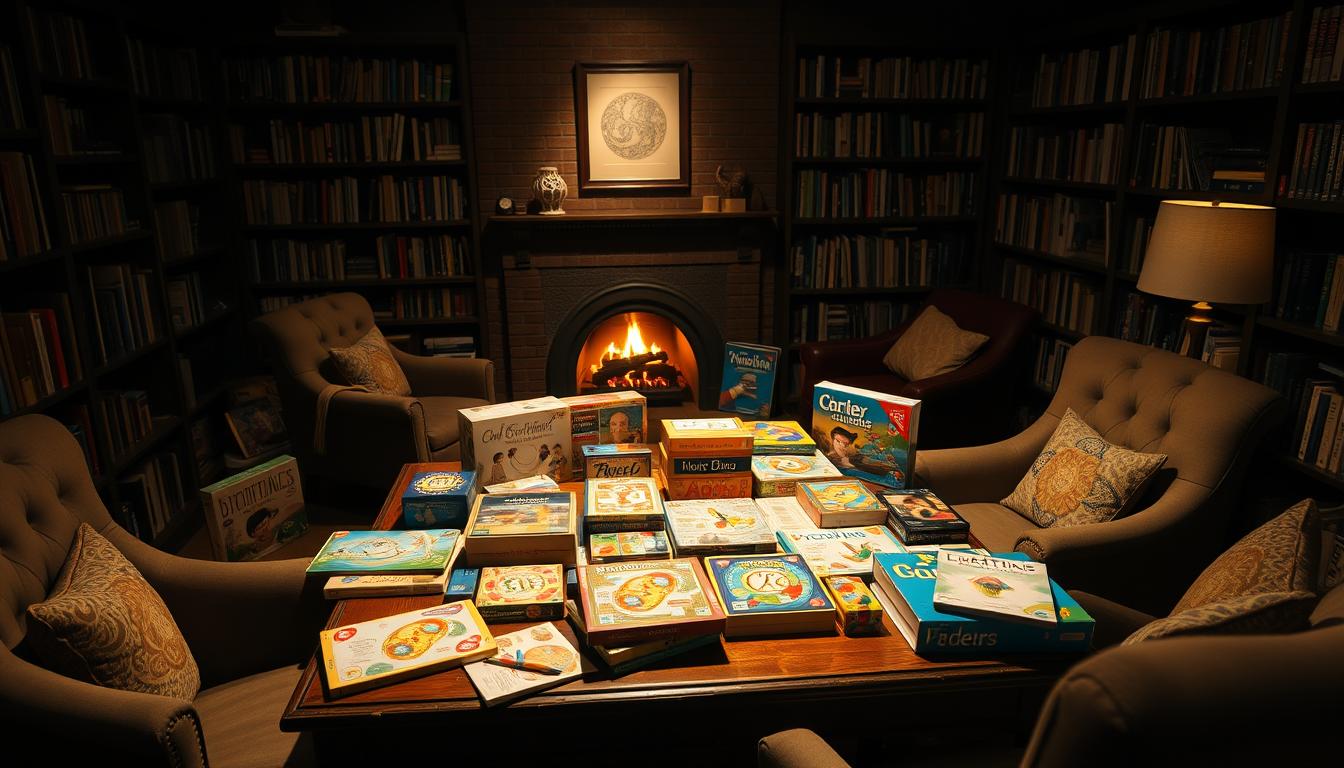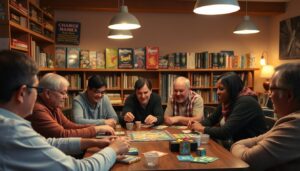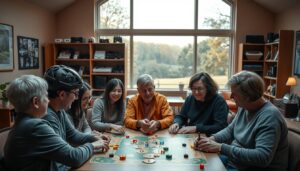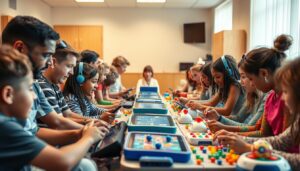Educational games combining colors and sounds to enhance memory
Ever wondered why some people remember things so well, while others forget easily? It might be because of games that mix colors and sounds to boost memory. This article looks into how these games can make learning fun and effective. We’ll see how they can change the way we learn in schools and at home.
The Power of Color and Sound in Learning
Colors and sounds are key in schools, making learning fun and easy to remember. Colors spark emotions, making lessons exciting. When students see bright colors, they stay focused and curious.
Sound helps students focus and remember better. Teachers use different sounds to make learning richer. This way, students learn more by using their senses.
When colors and sounds come together, learning becomes interactive. This mix helps students connect with what they’re learning. It makes learning a fun, memorable experience.
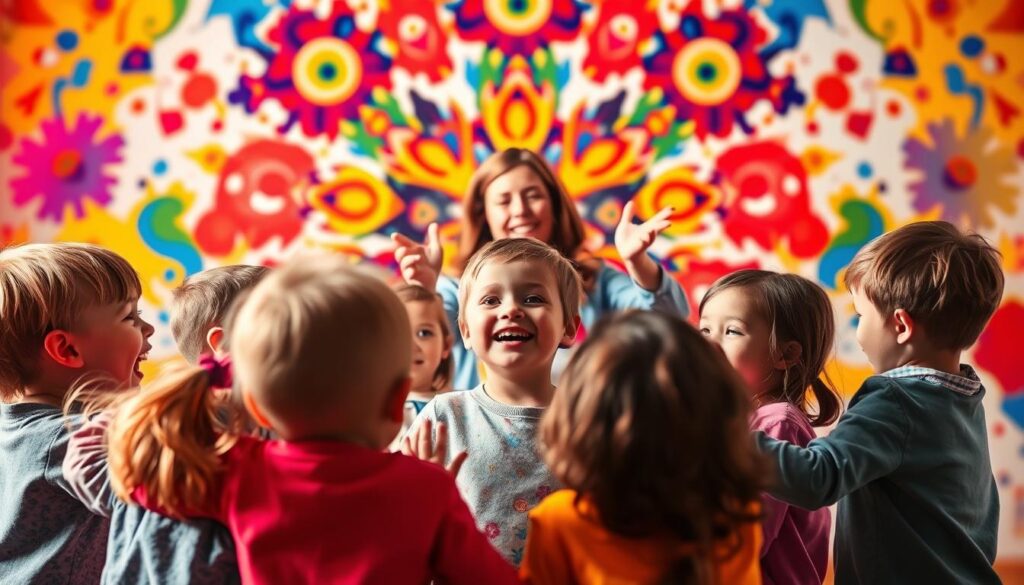
Understanding Memory Enhancement Through Play
Play is a great way to improve memory. It makes learning fun and engaging. Games with colors and sounds spark curiosity, helping us focus and remember better.
Play with different senses grabs our attention and boosts brain activity. It makes learning an adventure, improving memory as we go. This shows how play and learning are connected, helping us grow smarter.
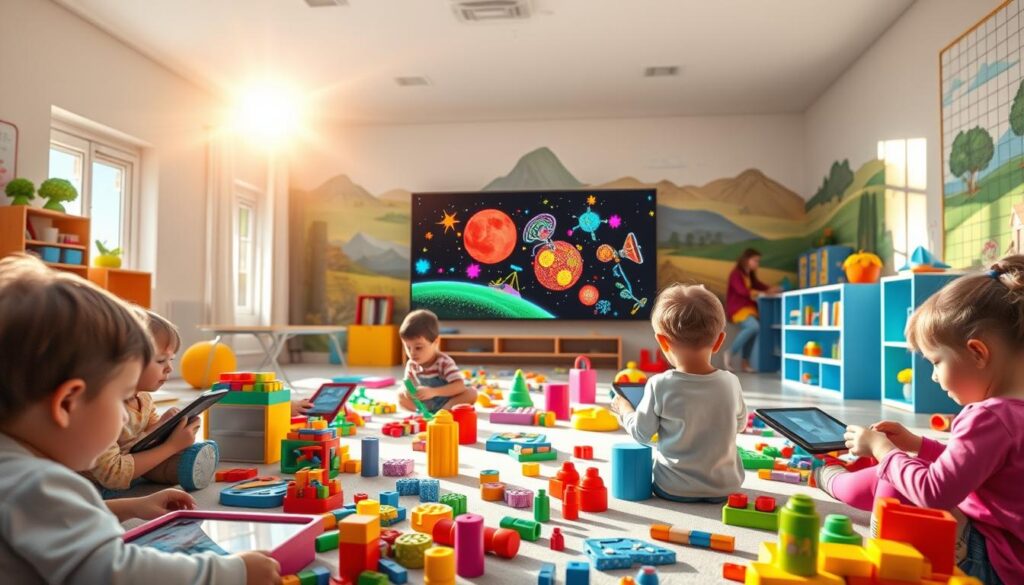
Adding educational games to our daily lives boosts memory. It makes learning fun, key to early education. These methods help kids grow smarter and do well in school.
Types of Educational Games for Memory Development
Educational games for memory development are diverse, each focusing on different skills. You’ll find matching games, puzzles, and tasks that test auditory recognition. These games are colorful and fun, making kids want to play.
Matching games help kids remember by matching cards with images or words. Puzzles improve critical thinking and spatial skills, boosting memory with each try. Auditory tasks help kids recognize sounds, enhancing their brain power.
Choosing the right game is key, based on the child’s age and development. Each game is tailored for different learning levels, ensuring kids get the most out of their play. By picking the right games, we help kids grow their memory and brain skills.
| Type of Game | Description | Primary Cognitive Skill Developed |
|---|---|---|
| Matching Games | Pairing cards with images or words | Recall and Spatial Awareness |
| Puzzle Games | Assembling pieces into complete pictures or concepts | Critical Thinking and Problem-Solving |
| Auditory Recognition Tasks | Identifying sounds from different sources | Sound Recognition and Memory Recall |
Benefits of Using Colors in Educational Games
Using colors in educational games brings many benefits. It makes learning more fun and engaging. Bright colors grab attention, making the game feel alive and interactive.
Colors help with visual learning too. They make different parts of the game stand out. This makes it easier to remember things, as colors help link to specific information.
Colors also affect our mood and motivation. They can make us feel better and more ready to learn. A colorful setting encourages players to dive in and explore.
In short, colors in educational games boost engagement and learning. They make learning fun for people of all ages. By using colors, educators and game makers can create better, more enjoyable learning tools.
Benefits of Sound in Educational Memory Games
In educational memory games, sound is key to a better learning experience. It does more than just entertain; it boosts how we process information. When sounds match what we see, we remember more. This mix of sound and sight makes learning more engaging and effective.
How Sound Stimuli Improve Cognitive Processing
Sound triggers many brain paths, helping us think better. By adding sound to games, students focus more and remember more. Sounds can also make learning feel more personal, making it stick in our minds.
When we hear sounds tied to what we’re learning, our brains are ready to recall. This helps us do well on tests or when applying what we’ve learned.
The Role of Sound in Retaining Information
Sound is a great tool for keeping information in our minds during games. Familiar sounds help players stay on track with their goals. Studies show kids who hear sounds while learning remember better over time.
By combining sound with what we see, games offer a complete learning experience. This supports the growth of our memory skills.
Brain Games with Visual and Auditory Stimuli
Playing brain games that mix visual and auditory elements boosts memory skills. These games need you to use both your eyes and ears. This makes your brain work harder, improving connections between different parts.
Tasks like remembering a sequence of colors and sounds are common. They make learning fun and also give your brain a good workout.
Using both senses in training makes learning more exciting. It shows how important it is to stimulate different senses. Here’s a table that lists various brain games, their features, and how they help improve memory:
| Brain Game | Type of Stimuli | Key Benefits |
|---|---|---|
| Sound & Sequence | Auditory and Visual | Improves recall abilities and attention span |
| Color Memory Match | Visual | Enhances visual recognition and memory retention |
| Musical Patterns | Auditory | Strengthens auditory processing and rhythm recognition |
| Story Soundtrack | Visual and Auditory | Boosts narrative understanding and immersive learning |
Popular Educational Games That Combine Colors and Sounds
Interactive learning games can make learning fun and effective. Games that mix colors and sounds help students remember better. They also improve thinking skills. Let’s look at two games that show how colors and sounds can make learning exciting.
Memory and Color – Mind and Brain Game
This game tests players to remember color sequences with sounds. It’s great for remembering things and recalling them when needed. The game’s bright colors and sounds make it engaging and help players remember more.
Shake & Match Sound Memory Game
This game is all about matching birds with their sounds while solving puzzles. It’s perfect for kids who love hands-on activities. It boosts thinking and fine motor skills while making learning fun.
How to Effectively Use These Games at Home
Start by setting a regular time for playing educational games. This makes learning a priority and creates a fun routine for kids. Playing together at the same time every day boosts memory skills and keeps things exciting.
Getting the whole family involved is key. When parents or siblings play too, it makes learning a team effort. This helps kids share their thoughts and builds a sense of togetherness.
It’s also important to pick games that kids enjoy. When games match their interests, they’re more likely to stay engaged. This approach keeps kids motivated and helps them remember more of what they learn.
Setting Up a Creative Learning Environment
Creating a good learning space is key for a child’s growth. It’s important to pick games that match their age and stage of development. The area should be cozy and free from distractions. It should also have things that catch the eye and ear to make learning fun.
Choosing the Right Games for Different Age Groups
Choosing the right games is crucial. Here are some ideas for different age groups:
- Preschoolers: Simple matching games and basic color identification tasks develop foundational skills.
- Early Elementary: Games that incorporate storytelling or problem-solving can engage children in more complex thinking.
- Older Children: Strategy-based games and multi-step challenges enhance critical thinking and teamwork.
Creating a space filled with the right games encourages curiosity and growth. It’s all about picking games that are right for their age.
Research Supporting Games for Memory Enhancement
Many studies have looked into how educational games help improve memory. These games are shown to boost learning results. They work by engaging more than one sense, helping us remember and recall better.
Studies on memory show that being active helps solidify memories. This is key to learning and remembering new things. Games make learning fun and tap into important thinking skills needed for memory.
Creating Your Own DIY Memory Games
DIY educational games are a great way to make learning fun. Parents and teachers can create memory games at home with simple materials. For example, colored paper adds color and sounds add excitement.
Custom games can match a child’s interests, making learning more fun. Using themes like animals or favorite cartoon characters helps kids connect better. This approach boosts creativity and makes memory games enjoyable.
To start, pick a theme, gather materials, and plan the game’s structure. Use cards with images and sounds for a richer experience. DIY games turn learning into an exciting journey.
Challenges and Considerations in Educational Games
Designing educational games comes with many challenges. It’s key to make sure the games are right for the age group. This ensures both safety and fun. For younger kids, games with small parts can be dangerous.
Parents and teachers need to pick games that fit the child’s age and needs. This helps in keeping them safe and interested in learning.
Age Appropriateness and Safety Concerns
Finding the right mix of fun and safety is crucial. Games that are right for a child’s age are safer and more effective. Always check the age recommendations on the game’s label.
Parents should also look at the game’s content. It should match the child’s learning level. This way, kids can enjoy playing without facing risks.
Balancing Fun and Learning
Another big challenge is making games both fun and educational. Games should keep kids interested and teach them something. A good game should spark curiosity and teach valuable lessons.
This approach keeps kids excited about learning. It makes them want to play and learn more.
| Challenge | Consideration |
|---|---|
| Age Appropriateness | Choose games that match the developmental stage of children. |
| Safety in Play | Avoid games with small pieces that may pose choking hazards. |
| Balancing Fun and Learning | Ensure games keep children engaged while promoting educational outcomes. |
Conclusion
Games that use colors and sounds are great for improving memory. They make learning fun by engaging our eyes and ears. This makes learning more enjoyable.
Studies show these games work well in schools and other learning places. They mix fun with learning, helping people of all ages. This boosts their skills and memory.
Using colors and sounds in games is key to better learning. It’s a big step towards new ways of teaching. It helps learners of all ages, making education better for everyone.
FAQ
What are educational games that enhance memory?
Educational games that boost memory use colors and sounds to grab learners’ attention. They help improve thinking skills and keep information in mind.
How do colors impact memory in educational games?
Colors in games can make learners feel certain ways and keep them interested. They help sort out different parts, making it easier to remember.
Why are sounds important in memory games?
Sounds help our brains process information better. They help us remember and recall things by acting as guides. This improves our ability to focus and remember.
What types of games are best for memory development?
Games that involve matching, solving puzzles, and recognizing sounds are great for memory. They make learning fun and help us remember better.
How can parents maximize the benefits of educational games at home?
Parents should set aside time for learning and play games together. Choose games that match your child’s interests to keep them engaged and learning.
What should I consider when choosing games for children?
Make sure the games are right for your child’s age and safe. They should be fun and also help them learn something new.
Are there studies supporting the effectiveness of games in enhancing memory?
Yes, many studies show that games that use our senses can really help us learn and remember. They support the idea that learning should be fun.
How can I create my own DIY memory games?
You can make your own games with simple things like colored paper and sounds. Make them special for your child to make learning more fun.


